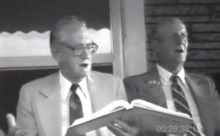Shape Note Singing
From "Corinth," The Sacred Harp, p. 32
Shape Note Singing
The term "shape notes" commonly refers to the system of music notation introduced during the nineteenth century as an aid in vocal music instruction. Their invention is attributed to William Little and William Smith who compiled a tunebook The Easy Instructor (ca. 1800).
Their use was promoted primarily by itinerant singing school teachers, many of whom compiled their own tunebooks and even developed their own notation systems. Most often the notation systems were registered with the patent office, thus they were sometimes called "patent notes. In their heyday, shape notes dominated the American music publishing industry and were familiar among the public. They were never adopted by major educational or religious institutions, however. Eventually they gave way to round notes in churches, common schools, and music academies, and ceased to be used by publishers.
The main function of the shapes was to easily convey the relationship of the printed notes to the degrees of the diatonic scale. Then and now, their success depends heavily on their repated use. In singing schools, classes practice singing the scales so as to affix the sound to the shape and its name. In the film, we see Terry Wootten leading a class of singers through scale exercises. Together they sing the names of the shape notes as he points to them-fa-sol-la-fa-sol-la-mi-fa.
But the bulk of a singer's experience comes at all-day singings, where singers sing the shapes for each song before singing the text. Over time, singers will have had many years of accumulated practice singing the shapes. Consequently, the shapes and their names become inextricably bound to the musical tones they represent, so that singers eventually hear the shapes in any music they experience.
Four-Shape System
The Sacred Harp uses the four-shape notation of Little and Smith's The Easy Instructor (ca. 1800). In this system, the diatonic scale is rendered by the sequence fa-sol-la-fa-sol-la-mi-fa. The term "fasola" singing, a common name for the four-shape system and style of music, is derived from the familiar fa-sol-la sequence. A similar system, which developed later and is associated with a more progressive sound, uses seven shapes to render the scale-do-re-mi-fa-sol-la-ti-do.
 Writing on "The History of Four-Shape Notes" (1904), Sacred Harp historian J. S. James traced the system to the ancient Greek tetrachord. The tetrachord was the fundamental melodic unit-two whole tones (e.g., fa-sol-la) with a leading half-tone below-from which scales were constructed.
Writing on "The History of Four-Shape Notes" (1904), Sacred Harp historian J. S. James traced the system to the ancient Greek tetrachord. The tetrachord was the fundamental melodic unit-two whole tones (e.g., fa-sol-la) with a leading half-tone below-from which scales were constructed.
In such a system the sequence fa-sol-la has the same two-whole-step structure no matter where in the scale it appears. Also, when any shape in the sequence is repeated (e.g., FA-sol-la-FA-sol-la-mi-FA) the resulting interval is either a fourth or a fifth-just as in the seven-shape system a repeated shape indicates an octave. Thus when novices in Sacred Harp ask, "why are there seven notes and only four shapes?," the genuine answer is that there are not seven notes but four.

